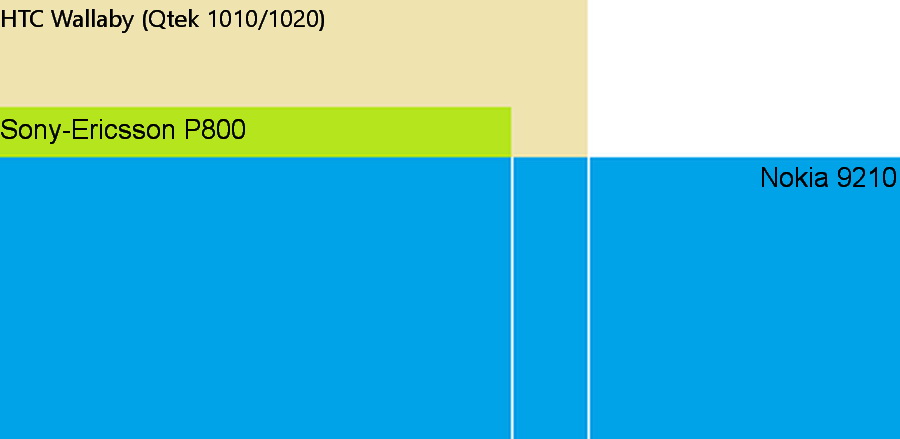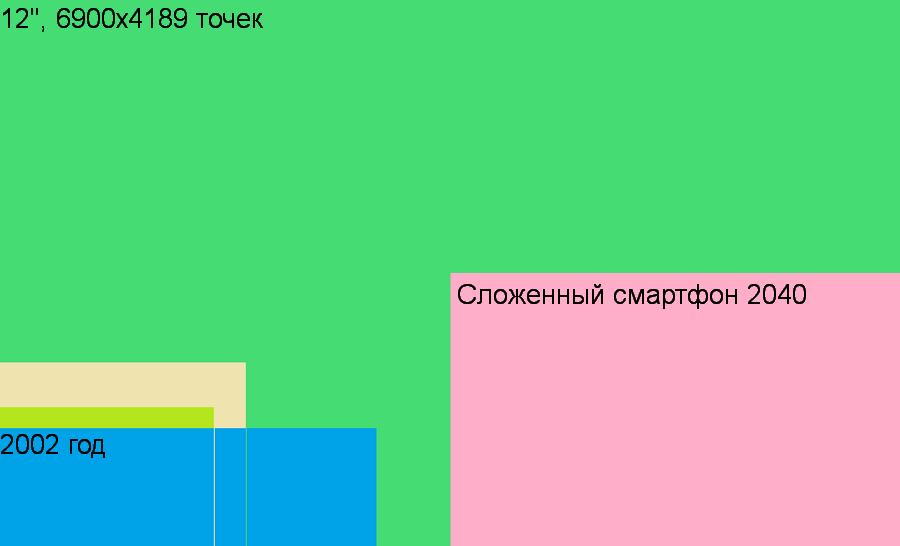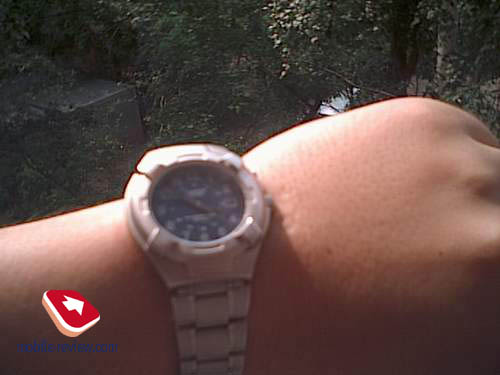2020 is ahead, the date, although not quite round, is beautiful. And how it relates to the prospects and development of mobile technologies in 2040, we will understand, taking a look at 20 years ago.

In numerology, the number 20 is a slow gestation and maturation, hidden from prying eyes. Let's try to look into the future based on what has matured in wearable electronics over the past 20 years.
Over the past 20 years, a new generation of people has grown up and began to think more or less meaningfully, and once young guys have moved to the rank of 'mature' and are almost grandparents, and deserved grandparents go about their business, and they definitely will not read this material . To assess the direction of development of electronics, it is necessary to divide a conventional smartphone into its component parts and say a few words about the software that works with all these components. Having understood how the basic characteristics of our smartphones have improved qualitatively and quantitatively, imagine a hypothetical smartphone in 2040. This is much more interesting than drawing another annual report, isn't it?
Form factor (appearance)
In 2002, three smartphones were released, which set the trend for the foreseeable future, they can be considered the ancestors of all modern smartphones. These are HTC Wallaby (Qtek 1010/1020), Sony-Ericsson P800 and Nokia 9210.

Let's agree that the presence of a flip-down keyboard or panels covering the screen in phone mode does not negate the fact that we have monoblocks with designs of varying complexity, objects that are hard and inflexible. All-in-one smartphones reigned until 2019, when the Samsung Galaxy Fold, the new Motorola Razr and Escobar Fold 1 entered the scene.

Meanwhile, rumors of the Galaxy Fold 2 have already surfaced on the web, mimicking the Razr's vertical fold. The dynamics of development is obvious, in the coming years more and more smartphones will go into the form factor of 'flexible' (let me put it that way), and conventional monoblocks will move into the category of 'inexpensive' and, as a result, 'not bright, not stylish, and not youth. ' At the very beginning, it was not for nothing that a period of 20 years was indicated and the replacement of 'old' users with new ones was announced. Agree, most of us are used to our monoblocks and do not want another, but this does not apply to young people who are ready to change every day. And the sales figures for the Galaxy Fold suggest that Samsung could sell a million devices by the end of the year, an unthinkable number for such an innovative device.

In light of the current dynamics of smartphone folding, one can assume that in 20 years there will be a smartphone that will fold twice, in fact, shrinking in size four times. It sounds incredible, but, friends, believe me, in 20 years we will not perceive it as we perceive it today, as 'not necessary', 'but what the hell', etc. Origami of a smartphone is inevitable, which does not negate the presence of classic smartphones.
Display
It is not particularly important for us to know which technology will be applied in the screens of smartphones of the future. Alas, real holographic screens never appeared, at least not of sane size, power consumption and readiness for mass production. There are no VR glasses that can be worn all day. But it's worth talking about the screen resolution and its diagonal. In the memorable year 2002, which opened the era of real smartphones, the screen resolution of good WM-smartphones was 320×240 pixels, 640×200 pixels for the Nokia 9210 and 320×208 pixels for the SE P800. Conceptually, the aspect ratio reached 16: 9 (and 'already') until 2019, the minimum screen resolution is 800×480 (ZTE Blade L130) pixels, and the maximum is 3120×1440 (OnePlus 7 Pro) pixels.

Comparison of 2002 screens by physical size
Simple calculations show that the average smartphone screen in 2002 had a resolution of 480×220 pixels, and in 2019 – 1960×960 pixels. The maximum and minimum values were taken, and then the arithmetic mean was calculated. Against the background of the fact that progress does not seem so significant (more recently, new smartphones 480x320px appeared), let's calculate the size of the supposed average smartphone in 2040.

Comparison of screens of 2002 and 2040 by physical size (not! Resolution)
While maintaining the linear growth rate of the smartphone screen resolution from the 2000s to the present day, the matrix of a smartphone in 2040 will be 6900×4189 pixels with a diagonal of ~ 6 inches (folded).
Working hours
The most difficult section, and there are reasons for this, since it depends on the scenarios of using our smartphone. In the very first smartphones, the ultimate dream was the presence of alarms and organizers (to-do lists), and low data transmission rates via GPRS put an end to the absorption of mobile traffic. Based on this, the 'complete program' in 2002 implied exactly the same scenario as in the good Java smartphones that came out a few years later. This is how the charge / discharge cycle of the SE P800 is described in the MR review:
The lithium polymer battery has a large capacity (1000 mAh), which requires a long charge, 4 hours is quite a lot. I repeat once again that you feel most comfortable leaving the P800 in the charger every evening, then you can use it to the fullest all day. In principle, this is a drawback of all devices of this class, their power consumption is too high. It makes no sense to buy P800 if you only need the functions of a phone, because in this mode the power consumption will still remain high.
If we talk about WM-smartphones (communicators), then an absolutely typical picture was the complete emptying of the charge when playing Xcom or HMM2 in one hour. Modern smartphones under gaming load work no less than 2 hours, and in the case of economical chipsets, you can play for half a day. It is impossible to say more precisely, the zoo of devices, batteries and other factors is too diverse. Based on this, it is quite appropriate to assume that the smartphone in 2040 will last at least 3 hours under maximum load.
Memory, chipset, performance
20 years ago, the internal storage was 12 MB for the SE P800), 14 MB for the Nokia 9210 and 32 MB in theory for HTC / Qtek. In theory, because with regard to WM-communicators, it was customary to indicate the total disk size, and not the amount available to the user. In the case of Symbian smartphones, the size of the RAM did not really matter, since the platform itself assumed the adaptation of each application to a specific smartphone model, which, to a large extent, played a cruel joke with the Symbian pushbuttons, taking them out of the big game.

For smartphones released in 2019, the minimum storage capacity can be found in program participants Android Go (for example, Xiaomi Redmi Go), and it is 8 GB. And at the same time, there is a Samsung Galaxy S10 + on the market with a truly galactic-sized 1TB storage.
Still, the variety is too great, so you will have to use an accessible method of rough counting for smartphone models (Apple + Android) released in 2019. There are 276 different smartphone models on sale in official retail, more than 50% of them are occupied by models with a memory capacity of 32 GB (52 units), 64 GB (66 units) and 128 GB (68 units), the arithmetic mean of the majority and will show us an objective picture. In 2019, the average size of main storage is 74 GB, in 2002 – 19 MB, which means that in 2040 the volume of the smartphone's storage can be 288 TB (288 210 526 MB).

In 2002, all mobile chipsets were single-core, and the physical structure of the computer itself was most like the 'big brothers' from the x86 camp – a processor separately, a Wi-Fi controller separately, etc. At the end of 2019, there are two CPUs on sale, with 4 or 8 cores. A simple calculation shows that 36-core ARM processors with a deep degree of independence from the OS software scheduler can be expected by 2040.
It makes sense to talk about performance only in the context of solving specific problems of 2040, about which nothing is known, and therefore there is a gap here.
Software
A lot has been done over the past 20 years, and the most important achievement can be considered a move away from application unification for a specific computing hardware towards cross-platform functionality within one OS. Installation software packages began to contain graphic elements for absolutely any screens, and the use of one or another physical device on the motherboard of a smartphone became an API. Developers under Android and iOS received tools that allow them to implement any idea, a platform for selling the fruits of their labor (application stores), everything that was not there in 2002. Nowadays it is even unusual to imagine purchasing applications via SMS, the advertisements of which could be found on the last page of a newspaper or magazine. For 20 years the world has changed so much that the very offer to 'buy a paper newspaper' is confusing, isn't it?

All these changes became possible only due to the growth of mobile Internet speeds, expansion of the volume of internal storage, hardware support for all processes. Objectively, there are only two mobile operating systems in which a good programmer and a user of his labor can carry out the procedure of exchanging 'goods' (services) for money, these are Android and iOS. Alas, there are only two of them, and there are no prerequisites for changing the situation. And therefore, suppose that in 20 years there will be Android and iOS, and development will follow the beaten path – applications will become 'weigh more', and the planet will continue to be voiced with disgruntled cries of owners of outdated smartphones.
Perhaps there will be a breakthrough in the field of security and a scanner of electromagnetic waves of the brain, or cameras will be able to distinguish the DNA strands of their host, but more likely the spread of radar in mobile devices as a smart lock and input device (Motion Sense in Pixel 4).
Communication capabilities
There are already grounds for rejecting the usual Wi-Fi and Bluetooth – connections due to their short range and unobvious financial benefits compared to the mobile Internet (LTE and 5G). I advise you to read an interesting study on this topic, and here I will share a few theses on this score. Considering 5G as a replacement for LTE, we are making a serious mistake – this is just a series of measures and means aimed at spreading high-speed mobile Internet, which can complement LTE connections, but not replace it, while increasing the connection speed to the network will not be ordinal. Whereas the proposed 6G communication protocol, expected after 2030 in the form of a clear concept, will be truly revolutionary. The introduction of AI tools at all levels of the process of transmitting and receiving information (intelligent power supply to an antenna amplifier as an example), a return to the idea of optical communication, global coverage, the transition to terabit speeds – these are just a few things that engineers dream about.

In 2002, we could only dream of this. Quote from SE P800 review:
In fact, this is the first device on the market with WAP 2.0 support. As a result, it is now possible to view not only wap-pages, but also ordinary html. Naturally, there are some limitations associated with the capabilities of small devices, but in general the second version is a big step forward.
WAP-Internet is a thing of the past, LTE support is increasingly common in the budget segment of push-button phones, which means that it is worth counting on a complete shutdown of 2G and 3G networks over the next 20 years.
Cameras
In 2002, a buyer could count on a camera built into a smartphone with a resolution of 0.3 MP (SE P800) or an external one attached to a special connector (Concord Q Eye in tandem with Nokia 9210). In both cases, we are talking about a 640×480 pixel image of extremely disgusting quality. But even that was enough to talk about the digital revolution, the opportunity to photograph an ad or a sign with a store's opening hours caused a 'wow effect' among those present.

Photo of Concord Q Eye (Nokia 9210)

SE P800 640x480px

Oppo Reno2 by Ilya Subbotin
For almost 20 years, the number of megapixels of a smartphone camera has grown more than 120 times, the product segment of inexpensive digital cameras has died, and the very 'number of megapixels' has become the last thing a buyer pays attention to. Focusing speed and low-light shooting became much more important parameters.
It is difficult to say which way the progress of mobile digital cameras will go, because the already existing 48 MP in an inexpensive smartphone (for example, in XIAOMI Redmi Note 8T) seems like an overkill. Tell us what progress you think is possible in this field.
Smartphone 2040
There is no need to talk about the appearance of the smartphone in 2040, because the desktop Android / iOS will be the whole 'design'. Already, high fashion offices are considering the use of flexible screens in their 'crowns', for example, OLED – panels in Louis Vuitton bags, which are planned for release in 2020. The bag hints that the flexible screen itself will become the main design element of the future:

TTX:
| Dimensions and weight | 280 x 160 x 1.8 mm, 18 grams |
| Material | Plastic |
| Display | 6900х4189 pixels, softIPS |
| OC | Google Android 29.0 |
| Chipset | Qualcomm Snapdragon 2450 (1nm technology), 36 Cortex A200 cores up to 3.8 GHz, Adreno 2200 |
| Memory | 240 GB RAM, 32 TB ROM (free 21.8 TB) |
| Wireless interfaces | All existing |
| Network | 4G LTE, 5G, 6G All in one |
| Navigation | GPS / GLONASS |
| Sensors and connectors | USB Type S (USB 5.0), Accelerometer, proximity sensor, light sensor, gyroscope, geomagnetic sensor, Fingerprint sensor on the entire plane, Unlock by face, retina, genetic code, by mental order |
| Main camera | 254 MP (f / 1.8) P DAF + 48 MP (f / 2.2) + 32 MP (depth sensor), LED flash, 8K video recording |
| Front-camera | 128 MP (f / 2.0), bokeh effect, you are the prettiest effect. |
| Battery | Li-Pol 4000 mAh, talk time up to 23 hours, video playback up to 18 hours, LTE battery life up to 14 hours Fast charging, 15W charger |
| Degree of protection | from fraying |
| Colors | black, red, blue and green, other countries have additional colors |
| Sound | FM radio |
| Payment system | Google Pay, Escobar Pay |
| Additionally | Four high-precision radars, in case of war, hand over the smartphone to the nearest air defense unit |
Conclusion
This funny picture caught my eye on the net:

In order not to become like the majority, it was decided to write a report not for a year, but for 20 years, and not the past, but the future. It is up to you to decide how far this has worked, in the comments I ask you to express your thoughts on the upcoming technical evolution. Ready to use a smartphone that looks a lot like a mouse pad? Or will it look more like a compact roll of wallpaper (roofing felt)? What do you think?
